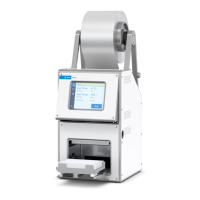13
PlateLoc Thermal Microplate Sealer
Frequently asked questions
Reference for Optimal Thermal Microplate Sealing
Evaporation verification and validation
Q
Do you have an established protocol we can use to test the PlateLoc seal for
permeability and evaporation?
A
A simple way to test for evaporation uses an experimental microplate and a
control such as a 100- g weight. Add an equal amount of water to all wells.
Weigh both the experimental microplate and the control. Seal the microplate.
Weigh both again. Place the experimental microplate into an oven to accelerate
the evaporation process (we suggest 65 °C for 3 hours or longer). Carefully
remove the microplate from the oven. Let it cool down to room temperature,
then weigh it again. Compare the initial and final weights of the experimental
microplate. Finally, weigh the control one more time to ensure the scale is
performing consistently.
Seal-peeling options and ergonomics
Q
We are presently hand- peeling seals from our microplates. We are now peeling
hundreds of microplates per day, and we are concerned about potential
repetitive motion injuries. What are our options?
A
Some labs choose to use pierceable seals which can be pierced using
automated piercing devices such as the Agilent Technologies Microplate Seal
Piercer. Another option is to use a microplate peeler device. These standalone
devices can be automated, and can be integrated with robotic microplate
handlers such as the Agilent Technologies BenchCel Microplate Handling
Workstation.
Short sample rolls
Q
Do you have free sample rolls of seal we can test with our microplates prior to
purchasing an entire roll of seal?
A
Contact Automation Solutions Technical Support for a wide variety of short,
sample rolls of seal for this purpose.
Low-profile microplate support
Q
We’d like to seal Aurora® 1536 low profile microplates. Is there a special
microplate support available to facilitate a good seal?
A
Yes. Contact Automation Solutions Technical Support and ask for PN 17708.001

